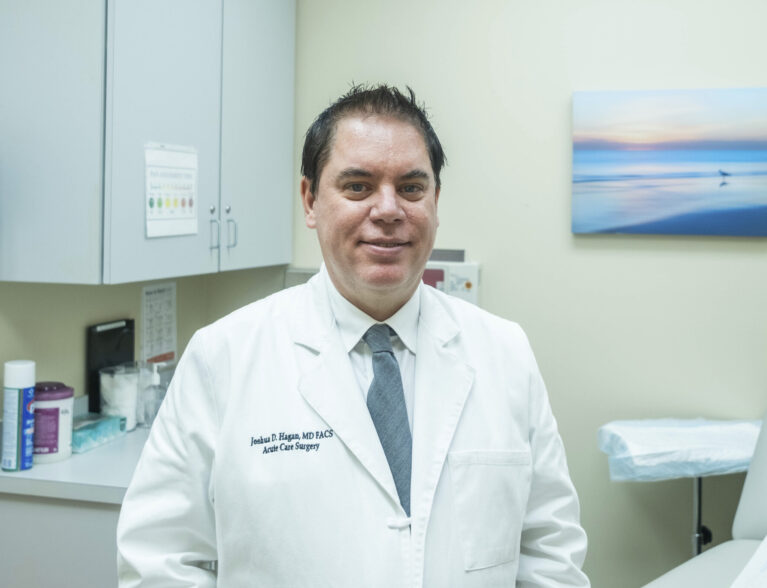
Have you noticed a bulge in your abdomen that appears when you stand, cough or strain – but disappears when you lie down? You may have an abdominal hernia. While hernias usually are not life-threatening, they don’t go away on their own and can sometimes lead to serious complications if left untreated.
The good news is that hernia treatment is getting better. Recent advancements include increased use of robotic surgery for improved precision and minimally invasive procedures, the use of artificial intelligence (AI) and machine learning to personalize treatment and predict complications, and the creation of novel biomaterials for mesh alternatives.
“A hernia is technically a protrusion or defect in the wall of the human body,” explained Dr. Joshua D. Hagan, a critical care surgeon at HCA Florida Lawnwood Hospital. “The most common place it occurs is in the abdomen, where a weakness in the muscle allows tissue or organs to push through. Other common sites include the groin and around the belly button. Oftentimes a bulge is found at the hernia site and is more prevalent in the evening.”
Hernias tend to be most noticeable when coughing, lifting, or rising from a sitting to a standing position and usually do not cause sharp pain.
There are several different kinds of hernias. An inguinal hernia occurs in the groin and is more common in men. An umbilical hernia appears near the belly button. An incisional hernia develops at the site of a previous surgical incision, while a hiatal hernia occurs when part of the stomach pushes up through the diaphragm. Unlike the others, a hiatal hernia usually doesn’t cause a visible bulge.
Exactly why hernias form isn’t always clear. According to Dr. Hagan, the process is usually related to small injuries or defects in the muscle, sometimes made worse by genetic predisposition or tissue disorders.
“Most commonly, it starts with a small weakness that worsens over time,” he said. “It can take 10 to 20 years to develop.”
Excessive strain, heavy lifting, coughing or contact sports can make the defect worse, and while these factors contribute, hernias can appear even in people who live relatively sedentary lives.
Everyday activities like walking and standing put pressure on the abdominal wall, and some people are simply more prone to developing them.
Other risk factors include aging, obesity, pregnancy, chronic constipation or straining, persistent coughing or sneezing, and previous abdominal surgeries.
Interestingly, Dr. Hagan noted that there is no clear evidence that people who lift heavy objects for a living are more likely to get hernias than those who don’t. He recalled one study suggesting that the sudden change in pressure from skydiving may increase the chance of a hernia, but aside from such extreme circumstances, the risk appears to be rather evenly distributed.
Hernias may cause little or no discomfort at first, but they typically grow larger over time. Pain or pressure at the site is common, especially during straining or lifting. In more serious cases, a hernia can become trapped, or incarcerated, which may cut off the blood supply to the tissue.
This is called strangulation and is considered a medical emergency. Warning signs include sudden severe pain, nausea, vomiting, fever, chills, or a bulge that becomes firm and does not disappear when lying down.
Not all hernias require immediate surgery, and in some cases a watchful waiting approach may be recommended if the hernia is small, asymptomatic and not growing. Devices such as hernia belts can sometimes help relieve discomfort.
When surgery is necessary, there are two main options. Minimally invasive robotic surgery uses very small incisions and a tiny camera to guide repair of the muscle wall. Patients usually recover more quickly, experience less pain, and often return home the same day. The more traditional open hernia repair involves making a larger incision, pushing the tissue back into place, and reinforcing the abdominal wall with a mesh material.
Plastic or synthetic mesh that stays in the body has been used in hernia repairs for many years, but resorbable mesh made from natural biomaterials that dissolve over time is now an option.
Biomaterials are made from animal or human tissue such as an intestine or skin.
Biomaterials are not without controversy, however. They are significantly more expensive, and their efficacy is still unclear. In a 2023 study published in the National Library of Medicine, biologic meshes resulted in increased hernia recurrences and surgical site infection. Current evidence supports uncoated synthetic mesh as the implant of choice for elective hernia repair.
“Anytime you have a hernia, there’s always a chance of recurrence,” Dr. Hagan said. “But overall recurrence rates are low – only about 2 to 3 percent after surgery – and if it does return, it can usually be repaired again with surgery.”
While not all hernias can be prevented, maintaining a healthy weight, practicing proper lifting techniques, treating chronic cough or constipation, and strengthening abdominal muscles with safe exercises can help reduce the risk.
Hernias are common and often manageable, but they should never be ignored. If you suspect you may have one, a quick evaluation by your doctor can determine the severity and guide you toward the right treatment before complications develop. With early detection and proper care, most people recover fully and return to their normal activities.
Dr. Joshua D. Hagan is a board-certified critical care surgeon at HCA Florida Lawnwood General Surgery. He received his medical degree and served his residency and fellowship at the University of Tennessee College of Medicine. He completed his internship at Boston Medical Center. His office is located at HCA Florida Lawnwood General Surgery, 2401 Frist Blvd., Suite 56, Fort Pierce. To schedule an appointment, call 772-297-6184.



